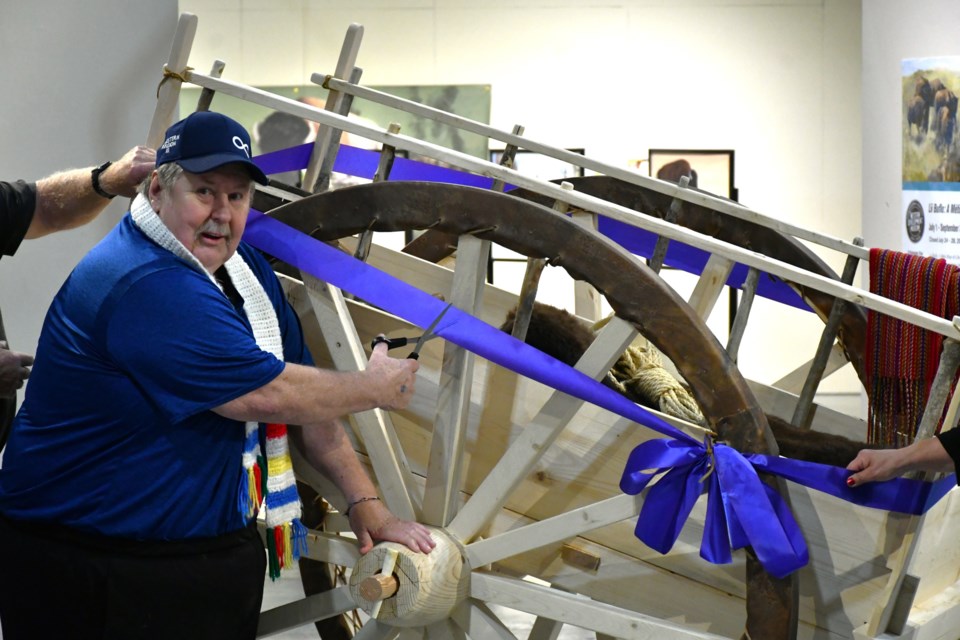MOOSE JAW — A full-size, traditionally built Red River cart now stands on permanent display at the Western Development Museum (WDM) in Moose Jaw — a proud reminder of the ingenuity, mobility and resilience of Métis people in the Prairies before the age of rail and paved highways.
The handcrafted cart, a collaborative project between the WDM and the New Southern Plains Métis Local No. 160, was officially unveiled recently during a public ceremony that drew visitors, dignitaries and community members to the museum.
“This unveiling … is a reminder of the importance of preserving our heritage for future generations, by understanding and considering our past, and building a stronger future for Métis culture,” said Hayley-Hart Rushinko, manager of communications and stakeholder relations with the City of Moose Jaw and Métis on her grandmother’s side.
The wooden cart, built without nails or screws using mortise and tenon joinery, was constructed over a period of two months by a small group of four local volunteers. Its wheels stand five feet tall and are wrapped in rawhide sourced from a Saskatchewan tannery.
“I have a lot of respect for the guys that built these 150 and 200 years ago,” said builder Rich Pickering, who worked on the cart in his own garage. “It’s a lot of work doing it all by hand. We have the advantage of having some modern tools, but using the chisels, the hammers, and the augers — yeah, it’s a lot of work.”
Pickering noted that one of the greatest challenges was sourcing rawhide and figuring out how long it would take to soak, lace, and dry — a process without any existing instruction manuals that ultimately took around four hours per wheel.
A second cart, this one made of metal but built to the same historical specifications, is slated to be installed soon at the Tourism Moose Jaw visitor kiosk on Thatcher Drive East as part of a Sask Polytech student project.
Darrell Hawman, president of the New Southern Plains Métis Local No. 160, said the project has been years in the making and plays a vital role in educating the public about Métis history on the Plains.
“Well, in today’s market, we say, if you got it, a semi brought it. If you got it in 1850, a Red River cart brought it,” Hawman said. “They would hook one ox-drawn cart to the tail end of another cart, and they would go in streams — sometimes up to 1,200 carts, but mostly in smaller groups of around 30 or 40.”
The carts — each capable of carrying up to 2,000 pounds (around 907 kilograms) — were central to the fur trade and buffalo hunting economies, forming part of a vast trail system across what is now Western Canada. Their size, durability and flexibility allowed them to serve as transport, shelter and even boats when necessary.
“They say if you look hard enough, you’ll find a trail under every major railroad or highway in Saskatchewan, and it’s true,” Hawman said. “And if you look hard enough, you’ll see the two grooves from the traveler, and then the Red River cart trails in the middle. So we followed First Nations (routes), then the Red River cart (trails), then the railroads.”
The unveiling ceremony highlighted the cart’s symbolic and functional legacy. Brian Martynook, WDM board member and Moose Jaw resident, emphasized the importance of collaborative heritage work.
“This exhibit is the result of meaningful collaboration that began in 2017,” he said, acknowledging the work of volunteers, staff, and Indigenous Elders and knowledge keepers. “Each of their contributions has helped ensure that the stories shared here are authentic, meaningful, and told from a proud Métis perspective.”
Interpretive signage accompanying the cart was co-developed by the Métis Local and the Gabriel Dumont Institute to provide cultural context and preserve oral history in permanent form.
As one of Saskatchewan’s earliest modes of transport, the Red River cart is a fitting and foundational addition to the WDM’s transportation collection.
Visitors can view the cart as part of the WDM’s permanent gallery during regular museum hours.



.png;w=120;h=80;mode=crop)
